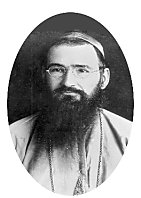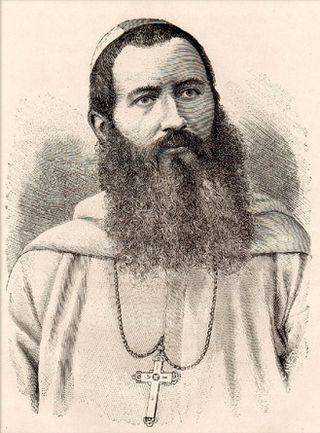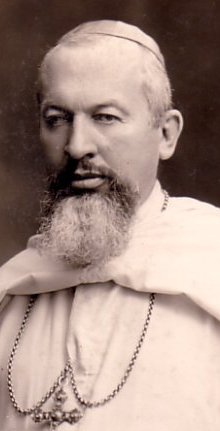Kalemie, formerly Albertville or Albertstad, is a city on the western shore of Lake Tanganyika in the Democratic Republic of the Congo. The Lukuga River, that drains Lake Tanganyika to the Lualaba River, runs through the city. Kalemie is the capital of Tanganyika Province.

The White Fathers, officially known as the Missionaries of Africa and abbreviated MAfr, are a Roman Catholic society of apostolic life of Pontifical Right founded in 1868 by then Archbishop of Algiers Charles-Martial Allemand-Lavigerie.

Lieutenant-general Baron Jules-Marie-Alphonse Jacques de Dixmude, often known as General Jacques, was a Belgian military figure of World War I and colonial advocate.
The Apostolic Vicariate of Tanganyika was a Catholic apostolic vicariate of the White Fathers missionary order at first centered on the mission of Karema in what is now Tanzania, that included parts of what are now Rwanda, Burundi, Democratic Republic of the Congo, Zambia and Malawi. As the number of missions, schools and converts grew, different regions became distinct vicariates covering portions of the original territory.
The Roman Catholic Diocese of Sumbawanga is a diocese located in Sumbawanga in the ecclesiastical province of Mbeya in Tanzania.

The Congo Arab war or Arab war was a colonial war fought between the Congo Free State and Arab-Swahili warlords associated with the Arab slave trade in the eastern regions of the Congo basin between 1892 and 1894.

Victor Roelens, M. Afr. was a Belgian Catholic priest who became Vicar Apostolic of Upper Congo in 1895, and remained the premier bishop in the Congo Free State, then the Belgian Congo, until he retired in 1941. He was a member of the Missionaries of Africa.

Antonin Guillermain was a Catholic missionary who was Vicar Apostolic of Northern Nyanza in what is now Uganda from January 1895 until his death in July 1896.

Léonce Bridoux, M. Afr. was a Catholic missionary of the White Fathers who became the Vicar Apostolic of Tanganyika.

Mpala is the location of an early Catholic mission in the Belgian Congo. A military station was established at Mpala on the shores of Lake Tanganyika in May 1883. It was transferred to the White Fathers missionaries in 1885. At one time it was hoped that it would form the nucleus of a Christian kingdom in the heart of Africa. However, after a military expedition had to be sent to protect the mission from destruction by local warlords in 1892, civil control returned to the Belgian colonial authorities. The first seminary in the Congo was established at Mpala, and later the mission played an important role in providing practical education to the people of the region.

Jean-Baptiste-Frézal Charbonnier, M.Afr. was a Catholic White Fathers missionary who was Vicar Apostolic of Tanganyika from January 1887 to March 1888.

Émile Pierre Joseph Storms was a Belgian soldier, explorer, and official for the Congo Free State. He is known for his work between 1882 and 1885 in establishing a European presence in the regions around Lake Tanganyika, during which he supported the White Fathers missionaries and attempted to suppress the East African slave trade. He is remembered for his ruthless fight against slavery and the capture and subsequent execution of the slave trader Lusinga.

Léopold Louis Joubert was a French soldier and lay missionary. He fought for the Papal States between 1860 and 1870 during the Italian unification, which he opposed. He later assisted the White Fathers missionaries in East Africa and played an important role in the suppression of the slave trade between 1885 and 1892. He married a local woman and settled by the shore of Lake Tanganyika, where he lived until his death at the age of eighty five.
Muhammad bin Khalfan bin Khamis al-Barwani, commonly known as Rumaliza, was an Arab trader of slaves and ivory, active in Central and East Africa in the last part of the nineteenth century. He was a member of the Arabian Barwani tribe. With the help of Tippu Tip he became Sultan of Ujiji. At one time he dominated the trade of Tanganyika, before being defeated by Belgian forces under Baron Francis Dhanis in January 1894.
Mulwewa was a mission founded by White Fathers missionaries on the west side of Lake Tanganyika, in what is now the Democratic Republic of the Congo. It is at Massanze, near Uvira.

Adolphe Lechaptois, M. Afr. was a priest of the White Fathers missionary society who was Vicar Apostolic of Tanganyika from 1891 until his death in 1917, in what is now Tanzania. He took responsibility for the vicariate at a time of great danger, when the missions were insecure havens for people fleeing slavers. As the country settled down, he oversaw expansion in the number of missions and schools. He was the author of a book on the ethnography of the local people that won a prize from the French Société de Géographie.
Lusinga Iwa Ng'ombe was a slave trader in the region to the west of Lake Tanganyika in the 1870s and early 1880s.

Joseph-Marie Birraux, M. Afr. was a Catholic bishop who was Vicar Apostolic of Tanganyika and later became Superior General of the White Fathers, or Society of Missionaries of Africa.
Mathurin Guillemé was a Catholic White Fathers missionary who was Vicar Apostolic of Nyassa in today's Malawi from 1911 until his resignation in 1934.
Adrien Atiman was a Catholic catechist and medical doctor.













